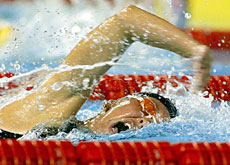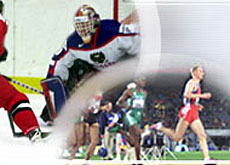Scientists warn of gene doping threat

Gene science experts meeting in Geneva have warned that genetic doping could become a real threat to the world of sport.
Concerns over genetically engineered athletes should be taken seriously, experts claim, even though gene therapy is still in its infancy.
The potential use of synthetic genes to cure people suffering from otherwise fatal diseases has made gene therapy one of the most talked-about fields in modern medicine.
But although gene therapy technology is only at the trial stage, some scientists fear that non-therapeutic methods might be used to make athletes run faster, jump higher or swim longer.
“Early suggestions that it might be possible to isolate a single gene responsible for physical speed or stamina have now proven over-simplistic,” Professor Sandro Rusconi of Fribourg University told swissinfo.
“But the study of multiple gene patterns could conceivably help us realise how these attributes are boosted.”
Gene manipulation
Speaking at a conference on “Genes and Sports”, organised in Geneva by the Lausanne-based International Academy of Sport Science and Technology, Rusconi said the identification and subsequent manipulation of these gene patterns remained a distant but highly possible threat.
“I believe we are still a long way off from clearly and safely identifying these gene patterns, but the history of doping in sport has frequently shown how eagerly people will reach for premature technology,” he warned.
“If I had to guess whether gene transfer would be abused first for sporting reasons or for cosmetic ones, then I would definitely go for sport. I just hope it doesn’t cause too much harm to the athletes themselves.”
For athletes wishing to boost their performance levels, the attraction of gene transfer technology lies in the apparent difficulty of detecting the transfer.
Instead of repeatedly injecting performance-enhancing hormones such as erythropoietin (or EPO) into their bloodstreams, athletes may be able to undergo a gene transfer, inserting the EPO gene directly into their cells.
Irreversible effects
But such treatments are currently considered almost impossible to reverse, making side effects (such as heart seizures and strokes in the case of EPO) much more likely for those athletes prepared to risk their health in the quest for gold medals.
“I don’t think we have to worry about gene doping becoming a reality within the next ten years,” reckons Dr Bernd Wolfarth of Germany’s Freiburg University.
“Right now, gene therapy is at a very basic level, so we are nowhere near being able to tell athletes about which genes could improve their performances in a practical way.
“If such circumstances were to arise, however, we would clearly be in a very sensitive situation and so we have to make sure now that the proper ethical considerations are being made.”
Many of the world’s major sporting organisations have at least expressed concern over the potential role of gene technology in future doping techniques.
Dick Pound, the president of the World Anti-Doping Agency (WADA) has even said that undetectable gene doping would mean that “sport, as we know it, will disappear.”
Heads in the sand
But faced with such a threat, the strategy of many sporting bodies has seemingly been to concentrate on traditional doping problems in the possible hope that gene doping never becomes reality.
The general sentiment at the Geneva meeting was that sports leaders should be doing more to tackle the problem before it arises, although some speakers suggested that anti-doping organisations would always be lagging behind technological advancements.
“Whenever one talks about people making laws, then they are almost always late,” points out Rusconi, “because it’s not possible to make laws about things which people are still struggling to understand.
“Ten years ago, though, people were still laughing about gene therapy being used as a form of doping. Now they’re no longer joking, because that seems to be the direction in which we’re heading.
“The laws needed to deal with this will almost intrinsically be late – the important thing is to ensure that they are not too late.”
swissinfo, Mark Ledsom in Geneva
According to the Human Genome Project, there are between 26,000 and 40,000 genes in the human body.
Around 97% of our DNA is known as “junk DNA”, having no known purpose.
It’s been estimated that at least 100 genes may play a part in determining athletic ability.

In compliance with the JTI standards
More: SWI swissinfo.ch certified by the Journalism Trust Initiative

You can find an overview of ongoing debates with our journalists here. Please join us!
If you want to start a conversation about a topic raised in this article or want to report factual errors, email us at english@swissinfo.ch.